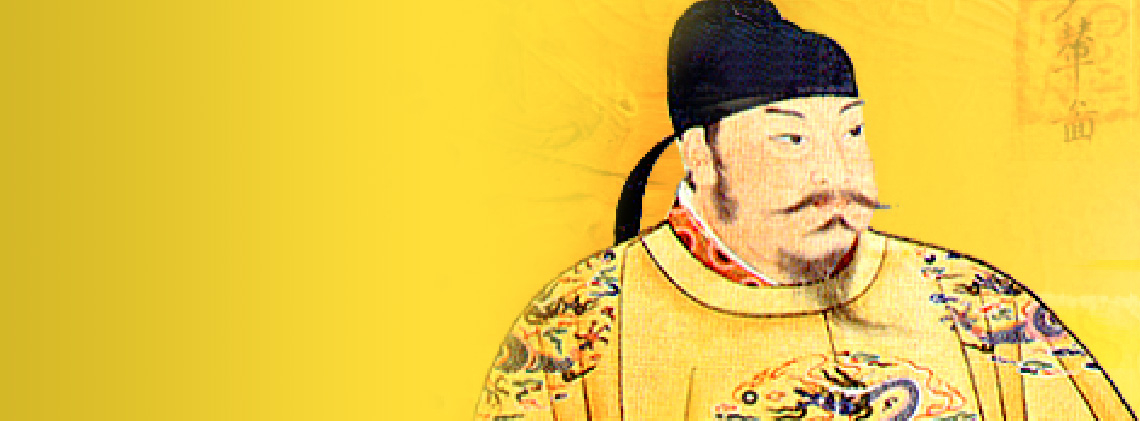
Emperor Taizong of the Tang
Splendid
Chi Culture
Topic
Emperor Taizong of the Tang
The Tang (618–907) was one of the most powerful dynasties in Chinese history. The fact that overseas Chinese sometimes refer to themselves as “Tang people” reflects the prestige of this period. The early Tang emperor Li Shimin (599–649) made outstanding contributions to the prosperity of the dynasty.
The Tang dynasty was founded by Li Yuan (566–635), an aristocrat of northwestern China, whose mother and wife belonged to the aristocracy of the Xianbei ethnic group. The Li family were also blood relatives with the imperial family of the Sui dynasty (581–618).
As one of the Sui emperor’s trusted generals, Li Yuan was ordered to suppress a popular uprising in Taiyuan, Shanxi. Realizing that the regime was in an inescapable decline, Li Yuan launched a revolt of his own to overthrow the Sui dynasty. He established the Tang dynasty in 618. Li Yuan’s four sons, Li Jiancheng (589–626), Li Shimin, Li Yuanba (599–614) who died young, and Li Yuanji (603–626), were all valiant military commanders. Having begun his military career with his father at age sixteen, the second son Li Shimin was made Prince of Qin, for his military contribution during the Taiyuan uprising.
Li Shimin was born on January 23, 599. Even after he became Prince of Qin at the age of nineteen, he continued taking part in military campaigns. He made remarkable contributions towards national reunification in the early Tang period and increasingly gained fame and prestige. Although Emperor Gaozu (Li Yuan) had decreed his eldest son Li Jiancheng the heir apparent, Li Shimin was determined to seize the throne.
In June, 626, Li Shimin conducted an ambush at Xuanwu Gate, the northern entrance to the imperial capital Chang’an. He personally killed his eldest brother Li Jiancheng with an arrow while his men killed his fourth brother Li Yuanji. This palace coup is known as the “Xuanwu Gate Incident,” following which Li Yuan was forced to abdicate, and Li Shiming ascended the imperial throne. He is known by his posthumous title of Taizong of the Tang.
The Han dynasty (206 BCE–220 CE) was a great and prosperous period. Emperor Taizong created another similar golden age called the “Reign of Zhenguan,” after his regnal title.
Adept at recruiting talented people, Emperor Taizong appointed the wise minister Wei Zheng (580–643) to the position of grand councilor. He became famous for his candid criticism of the emperor’s decisions. Although sometimes enraged by the grand councilor’s bluntness, the emperor always treated him with great tolerance. After Wei Zheng’s death, Taizong commented that “using bronze as a mirror allows one to keep his clothes neat. Using history as a mirror allows one to see the rise and fall of the empire. Using a person as a mirror allows one to tell right and wrong. When Wei Zheng died, I lost a mirror.” This famous saying has often been cited by later generations.
Adopting measures to facilitate production, and reduce corvée labor to bring relief to the people, Emperor Taizong built up a strong economic base for a prosperous dynasty within a short period of time.
China’s imperial examination system, first begun in the Sui dynasty, was set on the right path in the Tang dynasty. Emperor Taizong paid close attention to the exams by personally reviewing each admission list of jinshi (presented scholars). By allowing Chinese scholars to rise from commoners to the ruling class, the imperial examination system dealt a heavy blow to the “aristocratic clan system” of the Wei and Jin dynasties which only allowed aristocratic members to gain political power.
During Emperor Taizong’s time, literature in China also thrived. The regular script created by Tang calligraphers is still in use as a model for today’s calligraphy students. Tang poems are routinely included in school textbooks. Similarly, Tang sculptures and paintings have been great inspiration for generations to come.
Through military campaigns against the Western Regions, Taizong restored transportation routes of the Silk Road. To cultivate a close relationship with the Tibetan Empire, he sent princess Wencheng (ca. 623–680) to marry Songtsän Gampo (617–650), the king of Tubo (Tibet).
High Buddhist monk Xuanzang’s (602–664) westward journey was the most far-reaching event in international cultural exchange during Emperor Taizong’s reign. Xuanzang traveled by way of today’s Xinjiang (China’s Xinjiang Uyghur Autonomous Region) and Central Asia, and reached Pakistan and India. He toured and studied in Pakistan, Nepal, and India, and returned with many Buddhist sutras which he later translated into Chinese in Chang’an. Xuanzang’s translation of the sutras has since been widely used by Buddhists.
In his later years, Taizong judged himself as having greatly surpassed his predecessors in military achievement, civil administration, and pacification of border regions. Although some historians criticized his arrogance as well as indulgence in sensual pleasures in his later years, Taizong of the Tang was a highly accomplished emperor in Chinese history.







